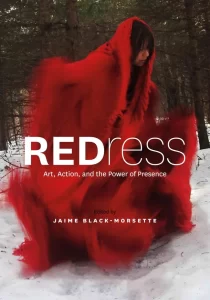Book review: REDress: Art, Action, and the Power of Presence
 Reviewed by Caroline MacKenzie
Reviewed by Caroline MacKenzie
REDress: Art, Action, and the Power of Presence is a collection of works by various authors, edited by Jaime Black-Moresette, with a foreword by Cathy Merrick. Black-Moresette is a Métis artist who, in 2010, created the REDress Project. This project involves putting red dresses in public areas as a call to action for Missing and Murdered Indigenous Women, Girls, and Two-Spirit people (MMIWG2S). The red dresses have come to symbolize both absence and presence and inspired Indigenous women, girls, and Two-Spirit people to reclaim their voices and their own space. These voices are joined by those of Elders, artists, academics, and family members.
This collection is poignant and heartfelt. The impact of these contributions comes from the fact that they are written by family members or friends of those who have been murdered and/or have never been found; the inclusion of victims’ names heightens the weight of this. The victim is no longer unknown but someone with a name and is loved.
In this book, the reader is confronted with the dangers and stigma uniquely faced by Indigenous women, girls, and Two-Spirit people. These are issues that many people have no knowledge or experience with, so this serves as an eye-opener.
The tone of this work is sad and dark. There is also a sense of hope that softens the tone. This stems from the willingness of the victims’ families and friends to talk about what has happened, showing that they have not been forgotten, giving hope that their cases might eventually be solved.
There are several themes throughout this compilation, which include change, strength, education, connection to the land, the importance of water, and the power of art. This strengthens one’s understanding of the REDress project and awareness of MMIWG2S and the chronic lack of attention these cases receive.
Related projects are also highlighted, including Walking With Our Sisters (WWOS), started by Métis artist Christi Belcourt. Her idea was to create a pathway of beaded vamps, each representing the interrupted life of MMIWGS2. There is also Red Shawl/Sacred MMIWG, a project composed of portraits by Anishinaabe photographer Nadya Kwandibens, centring on the victim’s family members.
This compilation includes poetry, op-ed style essays, personal stories, and songs. This means that there is a form of writing for different tastes. Readers will find a style that resonates with them, enhancing their understanding of this topic.
The inclusion of photos helps the reader to visualize the installation of the red dresses. There are also pictures of women wearing different styles of red dresses in various settings and poses, depicting the strength of Indigenous women. This reinforces the message of this book.
The reader also learns the significance of the colour red. In Métis and Indigenous culture, it represents power and strength and is used in ceremonies in the form of red cloth. It has also come to symbolize grief in the MMIWGS2 movement.
Some contributors use Indigenous languages in their writings, adding to the significance of the words, reinforcing their message. It gives Indigenous people a connection to their language and culture while exposing non-Indigenous people to Indigenous languages and traditions.
REDress: Art, Action, and the Power of Presence is an inspirational, educational, and heartbreaking collection that serves to educate about MMIWG2S and other related projects. It increases society’s awareness of this serious topic. Those with no connection to MMIWG2S learn about this issue and its wide-reaching impact. This book is an important tool as we unearth the truth and move towards reconciliation.
Jaime Black-Morsette, REDress: Art, Action, and the Power of Presence. Winnipeg: Highwater Press, 2025.
ISBN 9781774921388

